The Drainage Program is responsible for over 45 wetland and stream restoration projects, resulting in approximately 180 acres of total restoration and habitat creation.
Restoration activities are put into practice in a variety of locations, including local schools (creating an outdoor classroom), backyards of private landowners (Smith and Battista), marginal agricultural fields, and along Tax Ditches (Duke Jobs, Solberg, and Haines).
The Carl Solberg stream and wetland restoration project is located in western Kent County and is part of the Chesapeake Bay Drainage Basin.
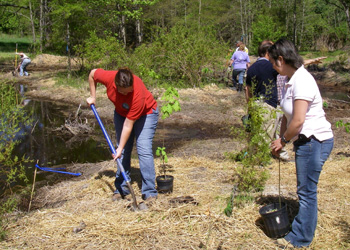 The project, a cooperative effort between the DNREC Ecological Restoration Team and the Kent Conservation District, restored 1,700 feet of stream, previously Prong B of the Marydel Tax Ditch.
The project, a cooperative effort between the DNREC Ecological Restoration Team and the Kent Conservation District, restored 1,700 feet of stream, previously Prong B of the Marydel Tax Ditch.
The project included elevating the ditch bottom, installing three water-control structures, creating a man-made beaver dam and creating two acres of floodplain wetlands adjacent to the original channel.
The entire tax ditch right-of-way has been eliminated. Portions of the tax ditch maintenance access-way have been restored to wetlands. The landowner purchased two additional acres of land along the tax ditch to complete the project.
A wetland planting event in the spring of 2007 brought in more than 30 volunteers including state and Kent County staff and private citizens.
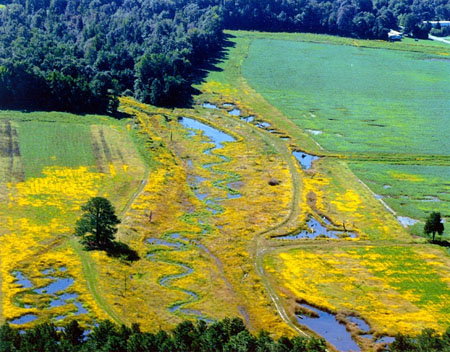 The Haines stream corridor and wetland restoration project was completed during the spring of 2003. This project involved the restoration of 1,600 linear feet of straight, steep-sided tax ditch channel (Petersburg Tax Ditch).
The Haines stream corridor and wetland restoration project was completed during the spring of 2003. This project involved the restoration of 1,600 linear feet of straight, steep-sided tax ditch channel (Petersburg Tax Ditch).
The tax ditch was restored to a natural flood plain stream system. In addition, approximately 7.75 acres of wetlands were restored in adjacent agricultural fields.
Among those helping out with this project were were students from Polytech High School and Sussex Tech High School who planted over 400 trees and shrubs.
The Duke Jobs Tax Ditch project reclaimed 5,900 linear feet of maintenance access-way along Prong 1 of the Duke Jobs Tax Ditch.
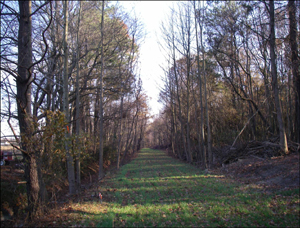 The project, a partnership involving DNREC, Duke Jobs Tax Ditch and the Sussex Conservation District, served as a demonstration of an environmentally friendly approach to Tax Ditch maintenance.
The project, a partnership involving DNREC, Duke Jobs Tax Ditch and the Sussex Conservation District, served as a demonstration of an environmentally friendly approach to Tax Ditch maintenance.
Trees growing within the maintenance roadway were selectively removed with some roots left to maintain soil stability. Larger trees with the most ecological value were kept to retain wildlife habitat and preserve forest canopy. Tree saplings were planted in specially selected areas to allow sufficient space for future maintenance dip-out of the Tax Ditch.
This method of tax ditch maintenance is unique and supports DNREC’s initiative to perform maintenance activities in a fashion less disturbing to the environment.
The Battista Wetland Restoration Project involved the restoration and enhancement of an abandoned agricultural field/pasture that was once a wetland.
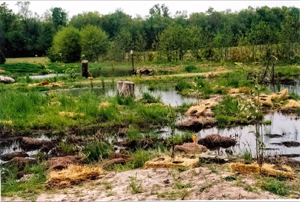 The project involved selectively excavating areas to a depth of of 12 to 18 inches to create pockets of water and small islands, just like in a natural wetland. Drainage was also eliminated to retain water.
The project involved selectively excavating areas to a depth of of 12 to 18 inches to create pockets of water and small islands, just like in a natural wetland. Drainage was also eliminated to retain water.
The unique part of this project involved building a half-acre wetland in the back yard of the property owner.
This backyard habitat compliments the flower gardens, butterfly gardens, and other plantings located immediately behind the 150-year old stone farm house.
Students from Polytech High School joined DNREC staff to plant approximately 200 native trees and. The majority of the plants were grown by the Polytech students.
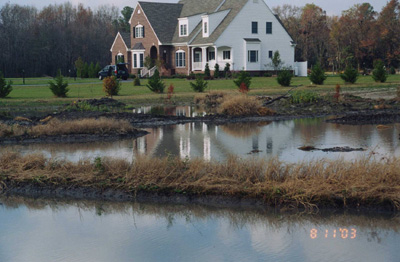 The Dave Smith Wetland Project involved the restoration of three acres of marginal agricultural field on two locations on the farm. These two wetland sites are within close proximately to the property owner’s home, and can be easily seen every morning from the kitchen window.
The Dave Smith Wetland Project involved the restoration of three acres of marginal agricultural field on two locations on the farm. These two wetland sites are within close proximately to the property owner’s home, and can be easily seen every morning from the kitchen window.
This project demonstrates that not all restoration activities are conducted in the “back forty” and out of sight. Mr. Smith also planted trees and grasses through the Delaware Conservation Reserve Enhancement Program in his remaining fields, which resulted in the total restoration of 35 acres.
Sussex Tech High School environmental science students and DNREC staff combined to plant around 450 trees and shrubs as part of the project.
Related Topics: conservation, drainage, flooding, restoration, stormwater, watershed, wetlands